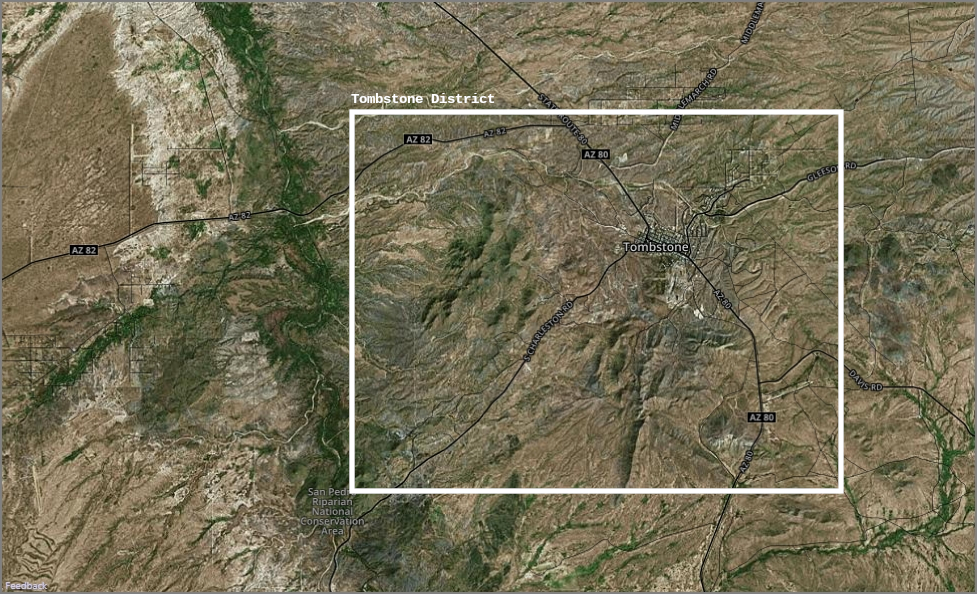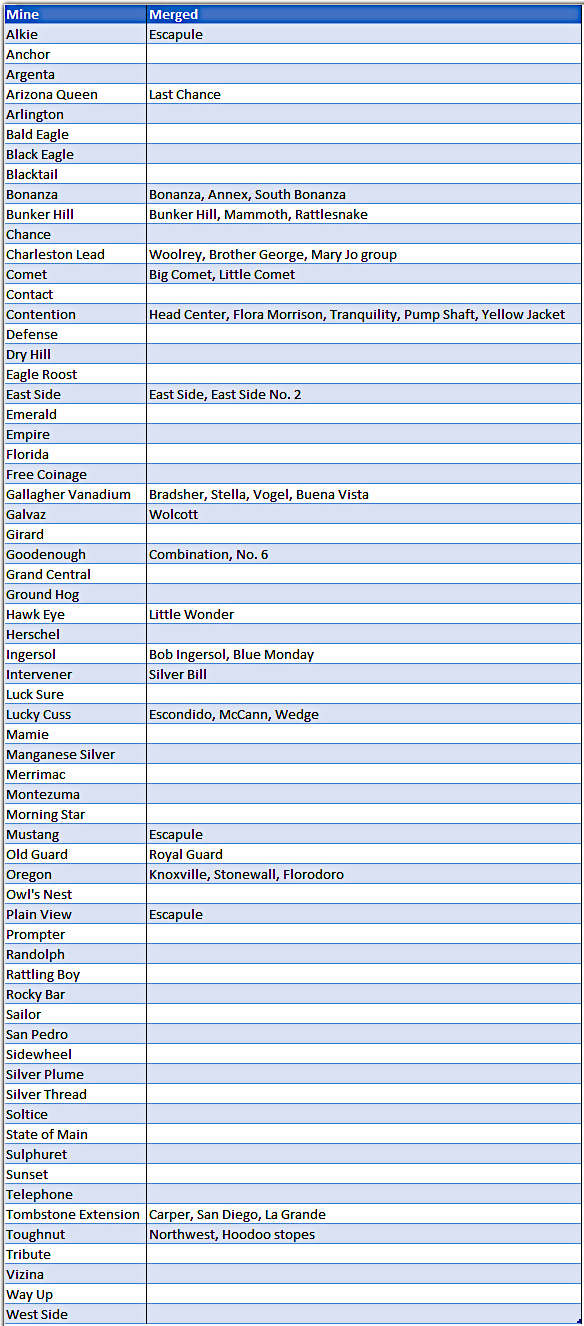Most folks know about the GoodEnough Silver Mine because of the tours, but Tombstone had many mines. This article describes the Tombstone Mining District, while another pinpoints some mining claims and shafts found near Tombstone's city.
Cochise County
In 1973, the Arizona Bureau of Geology and Mineral Technology published an "Index of Mining Properties in Cochise County." That report divides Cochise County into 18 different mining districts, as follows.
- California (Chirichua). In the modern Chiricahua Monument area near Willcox. The major producer was the mine at Galeyville, where lead and silver were mined. The total value of all ore extracted amounts to about $1.75M.
- Cochise. Near Benson, mainly north of the present-day I-10. Major metals were copper, lead, zinc, silver, and gold. In the early 1900s, it was a major tungsten producer. The total value of all production was over $32M.
- Dos Cabezas - Teviston. East of Willcox in the Dos Cabazes mountains. These are small mines producing copper, lead, zinc, silver, and some gold worth a total of $1.8M.
- Douglas (Ash Peak). This is a volcanic area and has had no major mining activity. It has produced some gypsum and volcanic cinder blocks used for construction.
- Dragoon. East of Benson in the north end of the Dragoon Mountains south of I-10. About the only major producer has been the Golden Rule (or Old Terrible) mine. It produced copper, lead, zinc, gold, and silver for a total value of $340,000.
- Huachuca Mountains. From Ft. Huachuca and south to Mexico. The district had only a few small mines that produced copper, lead, zinc, gold and silver worth a total of $140,000.
- Middle Pass. Gleeson road through the Dragoons. There were only a few small mines and they were worked for only a few years at a time. The district produced copper, lead, zinc, gold, and silver for a total production of $1.7M.
- Paul Spur. Tiny district south and east of Warren, near the border of Mexico west of Douglas. This district has no metal deposits and is noted only for Limestone operations.
- Pearce. East of the Dragoons, near Pearce, in the middle of the Sulphur Spring Valley. The Commonwealth mine is responsible for nearly all activity in the district. It produced copper, lead, silver, and gold for a total value of $10.6M.
- Peloncillo. Where I-10 crosses into New Mexico. This district has never been mined and only a few weak oxidized copper deposits have been found.
- Rucker Canyon. East of Elfrida, about half-way between AZ 191 and AZ 80. This district has produced only a few tons of metal ore and has never had any significant commercial mines.
- Swisshelm. East of Elfrida. Mines have produced copper, lead, zinc, silver, and gold worth a total of $2M.
- Tombstone. (See below)
- Turquoise. East of the Dragoons, near Elfrida. Indians extracted turquois from this area long before white prospectors discovered silver in the 1850s. The major producers were Gleeson (silver) and Courtland (copper). The major metals were copper, lead, zinc, gold, and silver for a total value of $14M. Additionally, there has been an unknown quantity of gem quality turquois extracted.
- Warren (Bisbee). This is, by far, the most productive area in Cochise County. The annual totals produced from this district has always exceeded the combined total of all other districts in Cochise County. The district has had both underground and pit mining operations. The major products have been copper, lead, zinc, gold, and silver. Additionally, manganese was shipped out in war years. The total value of this district's production exceeds $1.9B.
- Whetstone. The western edge of Cochise County, near the modern town of Whetstone. Mines in this area have been relatively small and shallow, yielding copper, silver, and gold. The total value of the district has been $14,000. Additionally, about 47 tons of low-grade uranium ore was shipped out of this district.
- Winchester. North of Benson and near the western edge of Cochise County. This district has had very little mining production.
- Yellowstone. North of I-10 east of Willcox. There were unconfirmed reports of gold production in the 1880s but there has been no known mineral production since then.
Tombstone Mining District
Mining in Cochise County can be traced back as early as the 1860s, but continuous Indian raids and general lawlessness in the area stopped any significant mining efforts. Tombstone's first intense mining activity started in 1878 with Ed Scheiffelin's discovery of the Tombstone Claim. Shortly afterward, he staked out several claims, including the Goodenough, Lucky Cuss, and Toughnut.
The map below highlights the boundary of what was considered the Tombstone Mining District. The city of Tombstone is near the center, but the district incorporates land to the San Pedro River on the west. The northwest corner of the district includes the former railhead at Fairbank, and the southwest corner includes the mill sites of Millville and Charleston.



